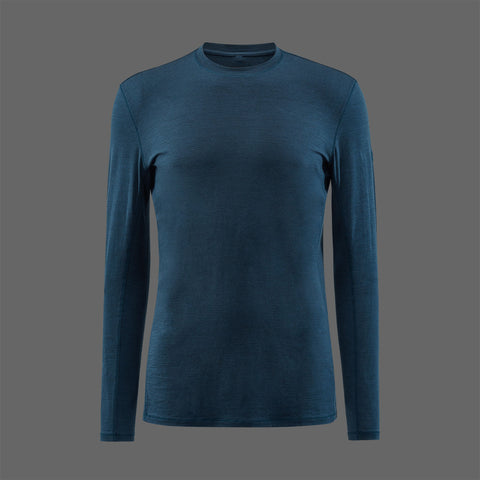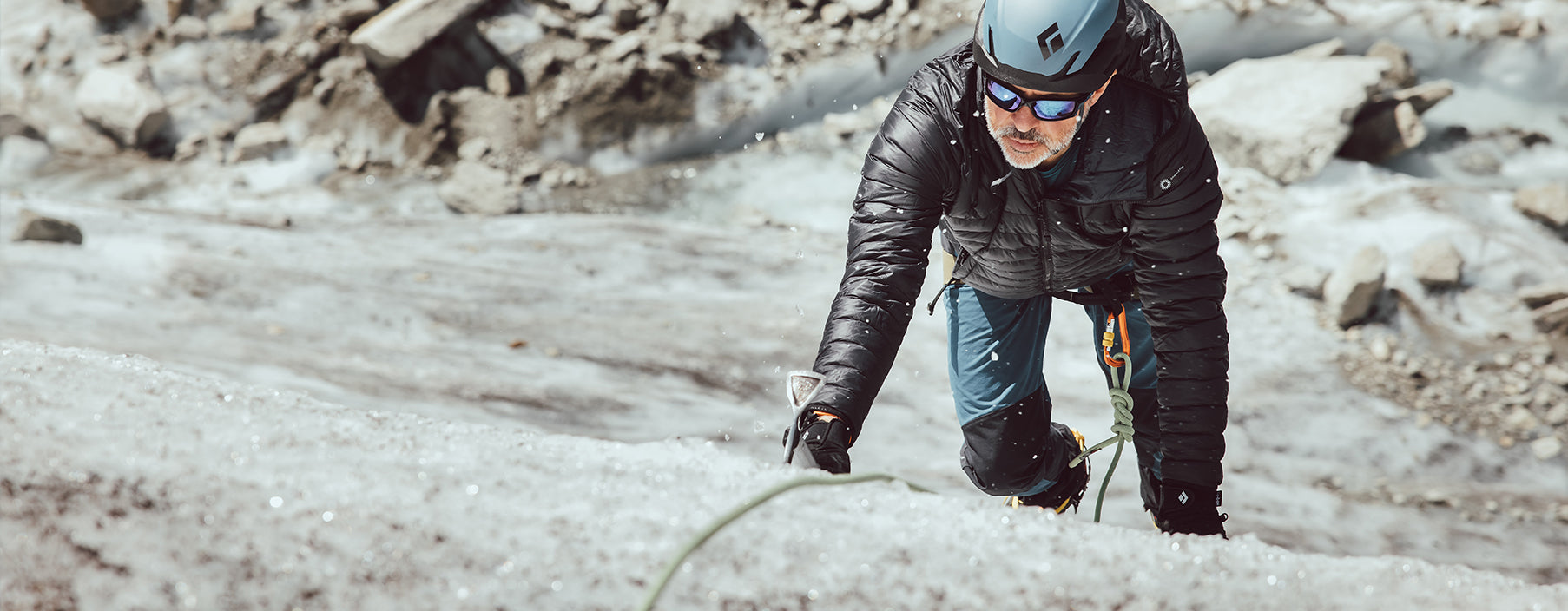
WHY MERINO? // A Shackleton Guide to Fibres
Written by Gord Betenia, Shackleton Head of Product Performance
Here at Shackleton we strive to use the most advanced performance materials out there. Though often this involves highly-technical newly developed fibres, there are instances where the best material to use is both naturally occurring and has been used for centuries.
As Sir Ernest Shackleton chose to equip his men in only the very best 100 years ago - including gabardine cotton jackets and wool-knit sweaters, so too we design only the best today. It is for this reason that we make the Dudley Polo Shirt, Nelson Baselayer and Docker Merino Sweater out of superfine Italian Merino wool to perform in extreme conditions, whether warm or cool.
What is Merino?
Merino wool is a natural fibre spun into yarn from the fleece of Merino sheep. Making up just 1% of the world’s apparel fibres, Merino is incredibly fine and soft, much more so than other wools, and it has renowned performance benefits to technical apparel.
A History of Merino Sheep
Thriving in arid climates, Merino sheep originated in Spain and were highly prized around the world for their fine wool. In 1797, the first Merino sheep from the famed Royal Merino Flocks of Spain, were introduced into Australia. Although the breed had already evolved a fine fibre, further selective breeding by Australian farmers soon produced an even finer wool. Nowadays Merino sheep and its crossbreeds are the basis of southern hemisphere fine wool production.
Merino Properties
The level of moisture management of Merino fibres has never been achieved with any artificially developed textile fibre. This means Merino is excellent at regulating your body’s temperature. When you are active and producing sweat, the fibres absorb moisture and then hold it away from the body and disperse that moisture away from the body and into the atmosphere (also known as 'wicking').
The wool fibres themselves absorb moisture through a chemical reaction. Because there is moisture on the body side, it’s absorbed from that direction. Assuming that the atmosphere on the outside of the fabric, away from the body, contains less moisture, the water will be released in that direction. Wool fibres will keep you warm again because they absorb moisture from the outside—they are able to hold 30 percent or more of their weight in water before they feel wet. The absorption and release of water to and from the body of the fibres creates a small amount of heat, but mostly it’s the moisture management itself that makes merino fabrics so comfortable. The other warmth factor comes from the insulating quality of the fabric; the spaces between the fibres and yarns buffer the temperature changes between body and outside world.
In warm conditions this helps to keep you cool and prevents overheating, as well as keeping you comfortable and dry. In cold conditions the wicking action means that there is relatively little moisture held next to the body. It is this moisture that would otherwise chill you rapidly when you stop moving. Moving moisture away from the body, combined with wool’s ability to absorb a significant amount of water without feeling wet, reduces the risk of hypothermia, and in less difficult situations simply promotes comfort.
In terms of moisture absorption, in comparison to Merino being able to hold around 30 percent of their weight in water before they feel wet, for synthetic fibres it’s less than ten percent. Merino fibres owe their high moisture absorption capacity to their chemical structure. They are hygroscopic, which means they can absorb moisture from the air in great quantities and very quickly. Sweat or rainwater is quickly transported to the inside of the fibre through a network of tiny channels.
At the same time, the fibre surface remains dry because it is water-resistant. This is why Merino wool still feels dry even when it has absorbed a lot of moisture. The hygroscopic fibres act like a storage tank that balances the moisture fluctuations in the environment.
Merino wool is naturally antibacterial, meaning that your sweat does not attract bacteria which helps to keep your Merino layers odour free. It is soft on your skin and non-allergenic. In addition, because Merino wool naturally retains moisture it is static resistant.
Merino wool fibres have elastic properties so Merino shirts and sweaters won't wrinkle or crease. This makes Merino apparel ideal for packing into your kit bag as it will bounce back into shape when you want to wear it.
Due to the fact that up to 90% of a Merino wool fibre is Keratin (like a rhino’s horn or human hair) it is completely biodegradable. If you were to bury a Merino sweater in the ground once you had worn it out, it would biodegrade in approximately 12 months. The earth would take back the fibrous protein composed of amino acids, releasing carbon and nutrients back into the soil.
How is Merino graded?
The softness of any fabric is measured by the diameter of the fibre used. Fibre diameter is measured in microns, a micron (μm) is one millionths of a metre. The finer the micron, the softer the fibre.
Merino is a very fine fibre, ranging from superfine ranging from superfine, 12-13 microns (Merino usually grown in Australia) to coarse, 25-26 microns. The bulk of Merino measures 20-23 microns.
Merino fibre is ⅓ the diameter of a human hair which is so fine that when it brushes against skin, it bends out of the way, making Merino apparel very comfortable.
Wool in general has a natural kink or wave in it. Coarse fibres have very few waves per inch - possibly as few as 1 to 5 per inch (less than 1/2 to 2 per centimetre), whereas fine fibres such as Merino may have as many as 30 waves per inch (12 per centimetre).
In this remarkable structure, the fine, wavy fibres lie so loosely on top of each other that air chambers can form between them. In relation to its total volume, a Merino fabric consists of a significant amount of air, making for excellent insulation.
Shackleton MERINO

| Docker Merino Sweater |
|
RWS (Responsible Wool Standard) certified Merino wool
|
|
Lightweight 12 gauge knit to keep in warmth and last longer
|
|
High collar with quarter zip
|
|
Naturally thermo-regulating and insulating
|
|
Water repellent and fast drying
|
|
Reinforced shoulder ribs add comfort and durability when wearing a rucksack
|
| Dudley Merino Polo |
|
100% Merino wool from Australia and New Zealand
|
|
Lightweight 12 gauge knit to keep in warmth and last longer
|
|
Naturally thermo-regulating and insulating
|
|
Water repellent and fast drying
|
|
Reinforced shoulder ribs add comfort and practicality
|
|
Corozo buttons
|
|
100% super fine Merino wool
|
|
Naturally thermo-regulating and insulating
|
|
Water repellent and fast drying
|
|
Lateral ribbing
|
|
Whole-knit seamless structure
|
| Wear next to skin as a base layer or over a T-shirt as a lightweight sweater |

| Lister Merino Long Sleeve T-Shirt Men |
|
100% super fine Merino wool
|
|
Highly breathable
|
|
Water repellent and fast drying
|
|
Naturally thermo-regulating and insulating
|
|
Odour-resistant
|
|
TencelTM fibres
|

| Supernal Merino Short Sleeve T-Shirt Men |
|
100% super fine Merino wool
|
|
Highly breathable
|
|
Water repellent and fast drying
|
|
Naturally thermo-regulating and insulating
|
|
Odour-resistant
|
|
TencelTM fibres
|
Gord Betenia lives in North Vancouver, BC (Canada). His background includes a combination of 18 years working within the product development sphere of the outdoor industry, balanced by over three decades of experience ice climbing, mountaineering and ski touring. Throughout his career Gord has been fascinated by the challenges of improving comfort and efficiency, especially in highly-demanding cold weather environments. Gord's work at Shackleton involves taking using his acquired knowledge and applying it as a foundation to help drive Shackleton product forward.




